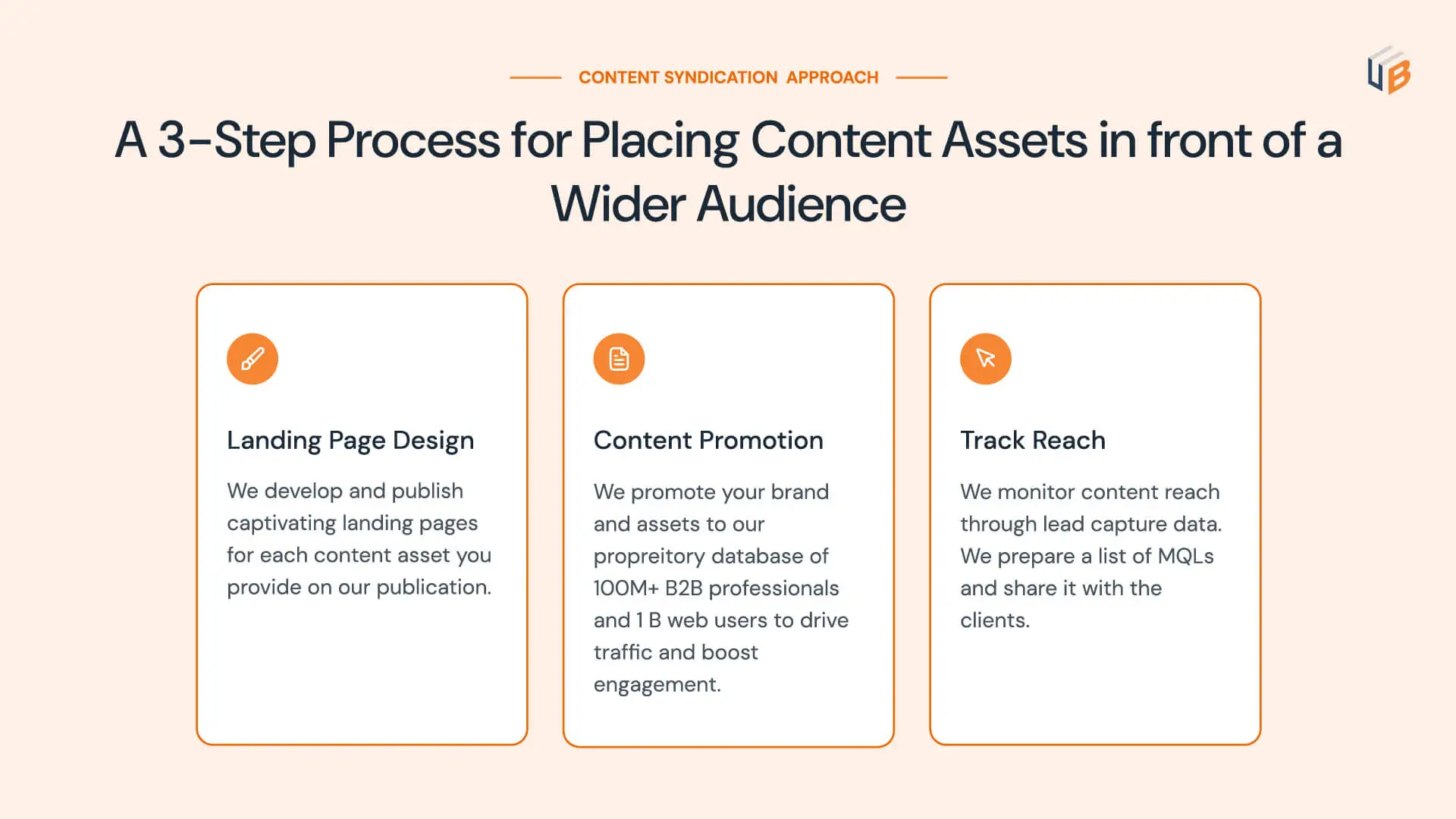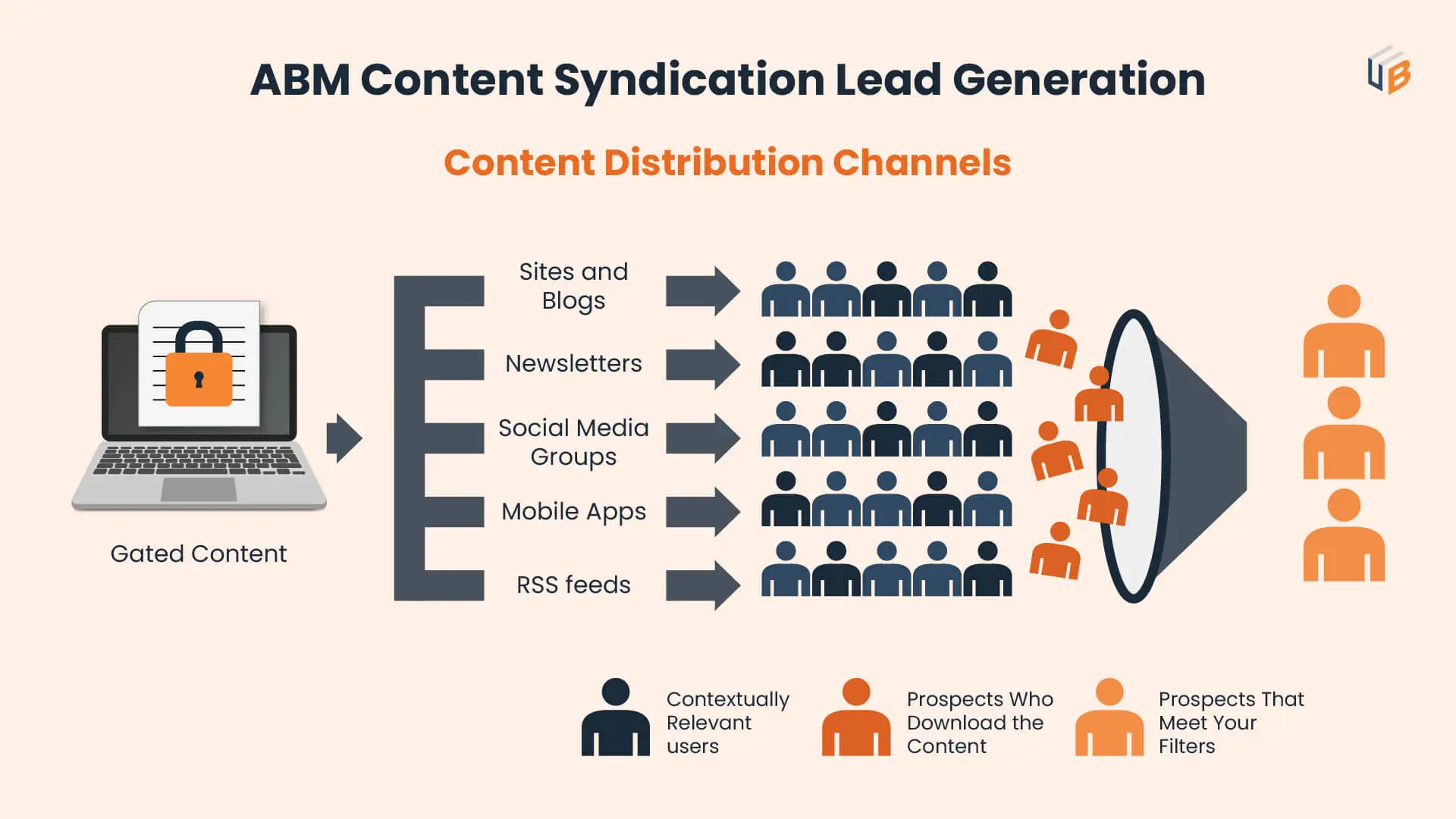
Introduction
Are you on the lookout for cost-effective ways to generate qualified ABM content syndication leads? Then chances are you’ve already built and implemented a content marketing strategy. 71% of B2B marketers have said that content marketing has become more important to their organization in the last year. You’ve also likely built a repository of top-notch content to target prospects in various stages of the buyer’s journey.
Executing a B2B lead generation strategy isn’t as simple as collecting contact information using lead magnets. You must leverage account-based marketing (ABM) to target specific market segments that are actively looking for your products.
While ABM involves various lead generation techniques, content syndication is one of the most powerful strategies in marketing. It’s a great way to grow your audience and amplify brand awareness. Also, it helps you break into new market segments. When correctly implemented, it even helps generate leads that are already interested in your brand/products.
If you’re new to the world of ABM content syndication, you might be wondering whether it’s worth a shot. Also, you’re likely unsure about the right way to get started.
That’s why I’ve curated a handy guide to walk you through the process of generating leads using ABM content syndication. But first, let’s dig deeper into content syndication and understand why it’s integral to account-based marketing.
A Closer Look At Content Syndication
Content syndication is the technique of distributing content that’s already been published on your company-owned digital assets. In other words, it refers to republishing original content from your blog/website to third-party websites.
You can use content syndication to distribute a wide array of content assets, such as:
- Blog posts
- Whitepapers
- Case studies
- Webinars
- Podcasts
- Videos
- Infographics
Instead of republishing the entire content, select traction-worthy excerpts from it to attract leads. Typically, the republished content is gated with a contact form for lead generation purposes. Also, it includes a link to the original content on your website. Here is how UnboundB2B provides its content syndication services.

Finding the right syndication partners is the most crucial aspect of successful ABM content syndication leads. The key is to identify high-authority websites whose audience matches the profile of your target accounts.
You can distribute your content on syndication networks, such as DemandWorks, NetLine, Outbrain, etc. Alternatively, you can publish excerpts of your content on social media platforms.
Another clever tactic is to republish your content on blogging platforms, such as Tumblr and Medium. It is beneficial to connect with reputed publishers, such as Forbes and HuffPost.
While you can republish content on social media platforms for free, high-authority syndication partners will charge a fee. However, the benefits of ABM content syndication outweigh the upfront investment.
Content Syndication & ABM: Exploring the Benefits
Content syndication offers various benefits, including increased reach and brand awareness. Also, it adds credible, high-quality backlinks to your blog from authoritative websites. It can even help drive organic traffic to your website and increase the shelf life of your content.
But when it comes to ABM, the biggest benefit of using content syndication is that you get to use razor-sharp targeting options. You no longer have to distribute your content all over the internet and wait for target buyers to come across it.
If you get the syndication partner selection right, you can connect with qualified leads who might be way ahead in the buyer’s journey. Your sales team won’t have to go through the trouble of educating the leads about their pain points and needs. Instead, they can directly position your product as the best fit for their problems.
The best part about ABM content syndication is that you can generate leads for each stage of your sales funnel. Also, it can help drive conversions and skyrocket your revenue.
What we particularly like about ABM content syndication is that it reinforces your brand authority and reputation. That’s because it helps associate your business with an established and high-authority website. This, in turn, improves your brand image and helps you grab the attention of qualified prospects.
How to Use ABM Content Syndication to Generate B2B Leads
Now that you know all about the benefits of content syndication, you must be eager to integrate it into your ABM strategy to maximize ABM content syndication leads. The good news is I’ve already compiled a guide to help you get started with it.
Here are the steps you should follow to build an ABM content syndication strategy for lead generation:

1. Dig Deeper Into Your Target Segments
If you’ve deployed account-based marketing campaigns, you must have already identified your target segments. You’ve got a fair idea of demographic parameters, including their age, location, professional background, current role, and responsibilities, etc.
Content syndication requires you to take it a step further and develop a firm understanding of your prospects. Delve deeper into their goals, aspirations, needs, and pain points. Identify the struggles they’re facing in their current role, as well as the tools/resources they wish they had access to.
Also, find out where each target segment is located on the buyer’s journey. Identify their pain struggles and preferences at each stage of the sales funnel too. Find the communication channels and devices they prefer to use.
2. Build a Personalized Content Strategy
The next step is to create a repository of content that’ll strike a chord with key stakeholders in your target accounts. If you’ve performed extensive market research, you already have a deep understanding of what problems they’re facing.
Publish high-quality original content that addresses their needs and offers solutions to their problems. Outline a content strategy and calendar to create a repository of top-performing blog posts, e-books, ultimate guides, tutorials, etc. We find it useful to repurpose written content into more eye-catching formats, such as infographics, animations, videos, podcasts, etc.
You could even host a webinar and summarize its key insights in a blog post. Or create an infographic to highlight the main takeaways from a whitepaper. Repurposing existing content in different formats is a cost-effective way of expanding your reach.
Make sure your content caters to prospects in different stages of the buyer’s journey. Identify topics and formats that’ll appeal to buyers at each stage. For instance, top-of-funnel prospects are interested in content that highlights and resolves their problems. Grab their attention using eye-catching infographics, explainer videos, and blog posts.
On the other hand, bottom-of-funnel leads want to know why your product is the right solution to their problems. It is preferred to use case studies to highlight product benefits and convert qualified leads into customers.
3. Choose Your Syndication Partners
This step decides the future of your ABM content syndication strategy. While social media and blogging platforms are effective content syndication channels, we recommend that you widen your search.
If you want to harness the full potential of content syndication, identify high-authority websites that your prospects will likely visit. Read their reviews to find out whether their existing clients have succeeded in ABM content syndication lead generation, and to what extent.
Also, look for syndication partners that’ll provide you with access to intent data. Intent data, stored in the form of cookies, helps you gain valuable insights into a prospect’s current needs. It even helps you identify leads who are actively looking for your brand/product.
Make sure your syndication partner offers APIs to support integration with your marketing automation and lead management platforms. Apart from third-party websites and content publishers, it is recommended that you leverage syndication networks to further amplify your reach.
4. Keep it SEO-Friendly
Content duplication is one of the biggest concerns related to ABM content syndication. If you’re worried about whether publishing duplicate content on other websites will affect your SEO strategy, we have good news for you.
There’s a simple way to ensure that the republished content doesn’t steal traffic away from your blog/website. You just have to check whether your syndication partner uses a “rel=canonical” tag for the repurposed content. The tag helps create a canonical link and points search engine spiders to the original source of the content.
It is preferable to take things up a notch by editing parts of the content to eliminate chances of duplication.
5. Outline a Lead Nurturing Strategy
Generating high-quality leads through ABM content syndication isn’t enough. If you want to maximize the ROI of your campaign, develop a framework for nurturing those leads. Have your sales reps follow up with prospects to better assess their requirements. Or use an automated email series to handhold them through the sales funnel.
6. Measure & Optimize
As with any marketing campaign, monitoring the performance of your ABM content syndication strategy is crucial. Assess the quantity and quality of ABM content syndication leads you generated through your syndication partners. Also, identify the percentage of leads that convert into customers. Use these insights to inform your decision-making and further improve your strategy.
Use ABM Content Syndication to Drive Revenue & Growth
Incorporating content syndication into your ABM strategy helps generate the best-quality ABM content syndication leads with a high buying intent. Develop a content strategy that caters to your target segments and addresses their needs at every stage of the buyer’s journey.
Also, select syndication partners that make a great fit for your industry and target demographics. Monitor and measure the performance of your strategy to ensure that the leads generated through these websites yield conversion and revenue.
Have you used ABM content syndication to connect with qualified B2B leads? Share your experience in the comments section below.
Our blog
Latest blog posts
Tool and strategies modern teams need to help their companies grow.

This comprehensive guide covers everything about service marketing—its unique chara...

Believe it or not, the concept of content sharing existed long before the Internet. I...

Sales analysis is essential to avoid inaccurate forecasts and identify improvement op...




